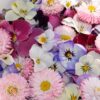Lemongrass (Cymbopogon citratus)
Lemongrass oil can be used as a lure when trapping bee swarms.
Description
A densely clumping perennial grass with cane-like stems and linear arching leaves that can reach up to 1.8m in height. Greenish flowers with a red tinge are borne in clusters in summer, but it rarely flowers in cultivation.
Related to the popular lemongrass (Cymbopogon citratis) is citronella grass (Cymbopogon nardus) and palmarossa (Cymbopogon martinii).
Ideal growing conditions
This tender perennial is not frost hardy and prefers a full sun site with not too much humidity, but moist soil.
Propagation
Seed: Sown in spring
Stem cuttings: From the swollen stem base at any time
Clump division when the main plant has grown too large
Harvesting
Leaf blades can be cut and used as needed – fresh or dried. The swollen bases of the stems are cut at ground level and can be used fresh, dried or frozen.
Uses
Culinary: With its fresh and subtle lemony flavour, lemon grass is an important ingredient in many South East Asian dishes, particularly Thai curries. Both the leaf blades and the stem bases are used to flavour fish, poultry, meat, sauces and vegetarian dishes. The leaves also make a delicious tea served either hot, or as an iced drink.
Medicinal: Its antifungal and antibacterial actions make lemongrass ideal for treating ringworm and athlete’s foot (externally) and minor feverish conditions (internally). It is is also listed as effective treatment for lice, scabies and arthritis.
Beauty: Cosmetically lemongrass oil (extracted) is used to cleanse oily skin, and to aid in relaxation. The oil is antiseptic and its fresh fragrance makes it a popular ingredient for soaps and perfumes.
Household: Lemon grass is often added to insect repellent mixes. Lemongrass oil is very effective as a lure to attract bee swarms to a new hive.

![By Miansari66 (Own work) [Public domain], via Wikimedia Commons Lemon grass dried](http://meadowsweet.co.nz/wp-content/uploads/2015/11/Lemon_Grass-150x150.jpg)

![By Miansari66 (Own work) [CC0], via Wikimedia Commons Lemon grass tea](http://meadowsweet.co.nz/wp-content/uploads/2015/11/Lemon_Grass_Tea-150x150.jpg)
![By Flickr user: boo licious http://www.flickr.com/photos/71284893@N00/ [CC BY 2.0 (http://creativecommons.org/licenses/by/2.0)], via Wikimedia Commons Satay lilit (minced seafood on lemongrass)](http://meadowsweet.co.nz/wp-content/uploads/2015/11/Satay_Lilit-150x150.jpg)
Sources
The Royal Horticultural Society Encyclopedia of Herbs, DK, 2008
The Complete Book of Herbs, Lesley Bremness, DK, 1995
Wikipedia





